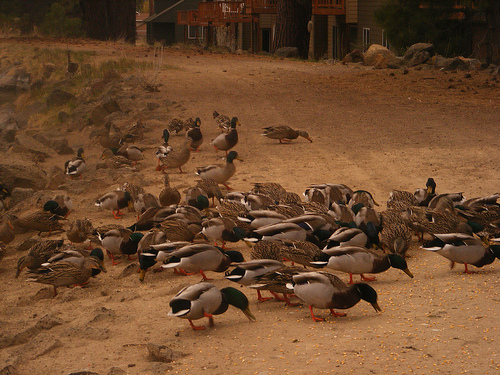Nutrition: When 5-star dining gets too expensive

Wild Mallards
Wild Mallards will eat and drink as needed
or as available to them. Most Mallards tend to have quite a
large appetite. The Mallard is omnivorous, feeding on anything
from nuts, fruits, rice,
Sweet Corn, and other types of grain, to
small fish, snails, worms, and even flies. Mallards will feed
both during the day and at night, although during the hunting
season, they will likely eat under the cover of darkness and
reserve being on higher alert during the daylight hours.
When the Mallards migrate in the spring and fall, a more readily available source of corn and seeds become a target as they fly over numerous farming communities. With their migration to a warmer climate in the fall, food consumption is easier than if the mallards stayed in the colder climate through the winter. Although, if the Mallards are migrating in cold weather with ice and snow present, streams and small springs that provide open water become desirable. They can be seen out looking for worms that so reliably come to the surface after a heavy rain. Mallards are often found congregating in shallow or heavily weeded waters (along with many other species of ducks) searching for snails or other small creatures.
Mallards raised on game farms
Mallards, as do most animals, need plenty of
water to stay healthy and grow quickly. For day-old Mallards, 3
gallons of fresh water per day should satisfy about 100
ducklings. As the ducks mature, more water may be necessary,
depending on how long the birds are kept on the farm.
The following feed information is based off of different
Purina Game Bird feed types considering mallards:
| Feed type | What age to feed | Feed suggested per week (lbs) |
| Startena | 0-6 weeks | 6.5 per bird |
| Finisher | 6-14 weeks | 12 per bird |
| Flight Conditioner | 6-16 weeks | 1.7 per bird |
| Breeder | Laying season | 1.8 per bird |
| Maintenance | After 16 weeks | 1.8 per bird |
Startena: Consists
of a 30%-protein ration designed to promote rapid growth through
bone and muscle development.
Finisher:
20%-protein ration designed to promote growth for mallards that
are to be sold for meat.
Flight Conditioner:
19%-protein ration designed to stimulate growth and feathering
with minimal body fat.
Breeder:
20%-protein ration formulated to promote egg production,
fertility, embryo development, and chick vigor.
Maintenance:
12.5%-protein ration is for birds that have reached maturity.
**The above information regarding the
Purina feed can be found at the link above and in the booklet A
Complete Guide To Game Bird Management cited in the
reference
section
Other Nutritional Information
Mallards have a complete digestive tract with a
digestive system used for the breakdown and absorption of
nutrients. Since the bill of the mallard doesn't allow for easy
pecking, crushing/chewing, or tearing, they Mallard uses the
help of its gizzard, just like the
Wild Turkey. The gizzard works in conjunction with the
true stomach of the animal to digest and absorb nutrients. The
gizzard performs the major breakdown of whatever food source is
consumed. If the Mallard eats some corn, the gizzard will break
it down, and its true stomach will further digest and absorb
nutrients. Many birds utilize a gizzard in order to fully digest
the food and maximize nutrient uptake.